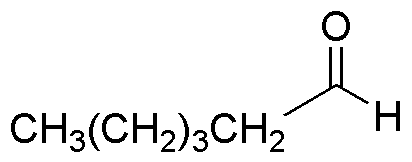Hexanal is widely utilized in research focused on:
- Flavoring and Fragrance Industry: Hexanal is commonly used as a flavoring agent in food products and as a fragrance component in perfumes due to its pleasant green, fruity aroma. This makes it valuable for creating appealing sensory experiences in consumer goods.
- Chemical Synthesis: It serves as a key intermediate in the synthesis of various organic compounds, including pharmaceuticals and agrochemicals. Researchers often use hexanal to develop new chemical entities with potential therapeutic benefits.
- Biopesticides: Hexanal has been explored for its potential as a natural pesticide. Its effectiveness in repelling certain pests offers an eco-friendly alternative to synthetic pesticides, appealing to the growing demand for sustainable agricultural practices.
- Analytical Chemistry: In laboratories, hexanal is utilized as a standard for calibrating instruments in gas chromatography. This ensures accurate analysis of volatile compounds in various samples, enhancing research reliability.
- Food Preservation: Hexanal has antioxidant properties that can help in extending the shelf life of food products. Its application in packaging materials can reduce spoilage, benefiting both manufacturers and consumers.
General Information
Properties
Safety and Regulations
Applications
Hexanal is widely utilized in research focused on:
- Flavoring and Fragrance Industry: Hexanal is commonly used as a flavoring agent in food products and as a fragrance component in perfumes due to its pleasant green, fruity aroma. This makes it valuable for creating appealing sensory experiences in consumer goods.
- Chemical Synthesis: It serves as a key intermediate in the synthesis of various organic compounds, including pharmaceuticals and agrochemicals. Researchers often use hexanal to develop new chemical entities with potential therapeutic benefits.
- Biopesticides: Hexanal has been explored for its potential as a natural pesticide. Its effectiveness in repelling certain pests offers an eco-friendly alternative to synthetic pesticides, appealing to the growing demand for sustainable agricultural practices.
- Analytical Chemistry: In laboratories, hexanal is utilized as a standard for calibrating instruments in gas chromatography. This ensures accurate analysis of volatile compounds in various samples, enhancing research reliability.
- Food Preservation: Hexanal has antioxidant properties that can help in extending the shelf life of food products. Its application in packaging materials can reduce spoilage, benefiting both manufacturers and consumers.
Documents
Safety Data Sheets (SDS)
The SDS provides comprehensive safety information on handling, storage, and disposal of the product.
Product Specification (PS)
The PS provides a comprehensive breakdown of the product’s properties, including chemical composition, physical state, purity, and storage requirements. It also details acceptable quality ranges and the product's intended applications.
Certificates of Analysis (COA)
Search for Certificates of Analysis (COA) by entering the products Lot Number. Lot and Batch Numbers can be found on a product’s label following the words ‘Lot’ or ‘Batch’.
*Catalog Number
*Lot Number
Certificates Of Origin (COO)
This COO confirms the country where the product was manufactured, and also details the materials and components used in it and whether it is derived from natural, synthetic, or other specific sources. This certificate may be required for customs, trade, and regulatory compliance.
*Catalog Number
*Lot Number
Safety Data Sheets (SDS)
The SDS provides comprehensive safety information on handling, storage, and disposal of the product.
DownloadProduct Specification (PS)
The PS provides a comprehensive breakdown of the product’s properties, including chemical composition, physical state, purity, and storage requirements. It also details acceptable quality ranges and the product's intended applications.
DownloadCertificates of Analysis (COA)
Search for Certificates of Analysis (COA) by entering the products Lot Number. Lot and Batch Numbers can be found on a product’s label following the words ‘Lot’ or ‘Batch’.
*Catalog Number
*Lot Number
Certificates Of Origin (COO)
This COO confirms the country where the product was manufactured, and also details the materials and components used in it and whether it is derived from natural, synthetic, or other specific sources. This certificate may be required for customs, trade, and regulatory compliance.

